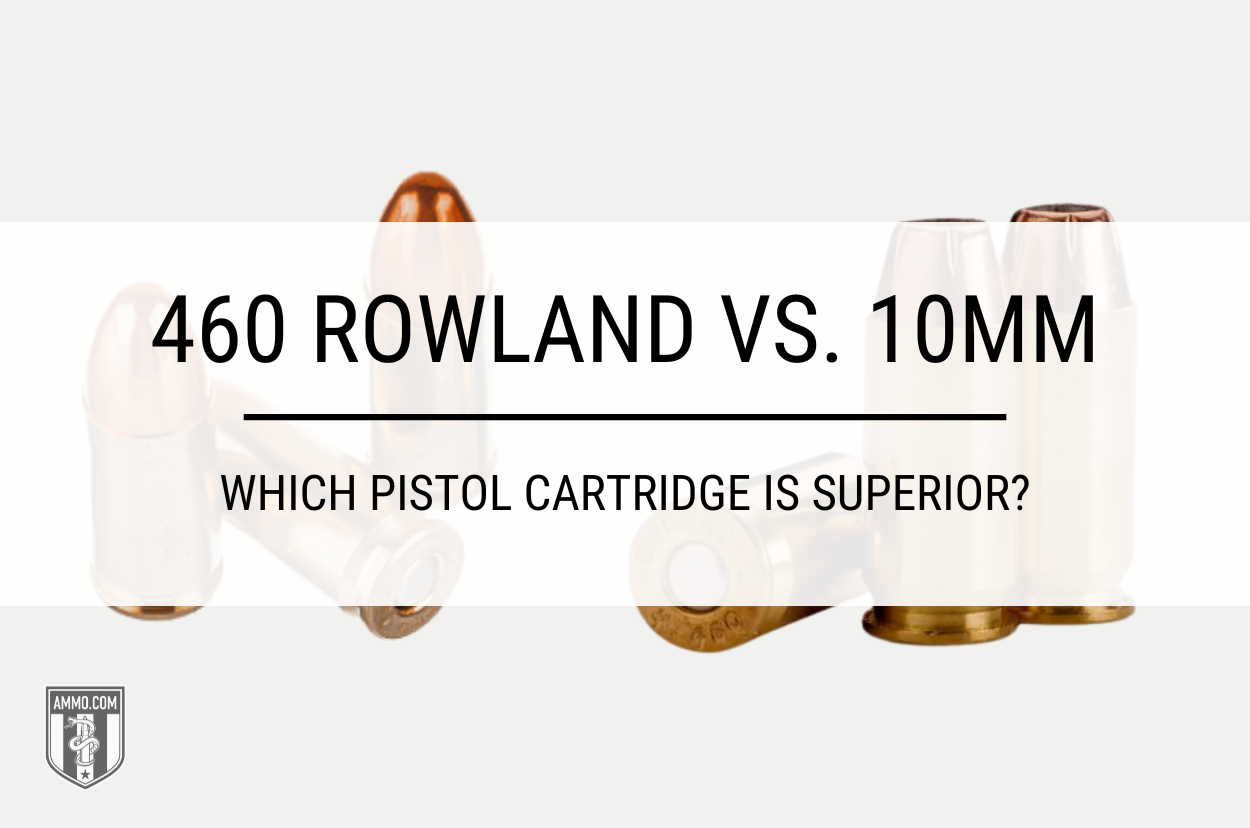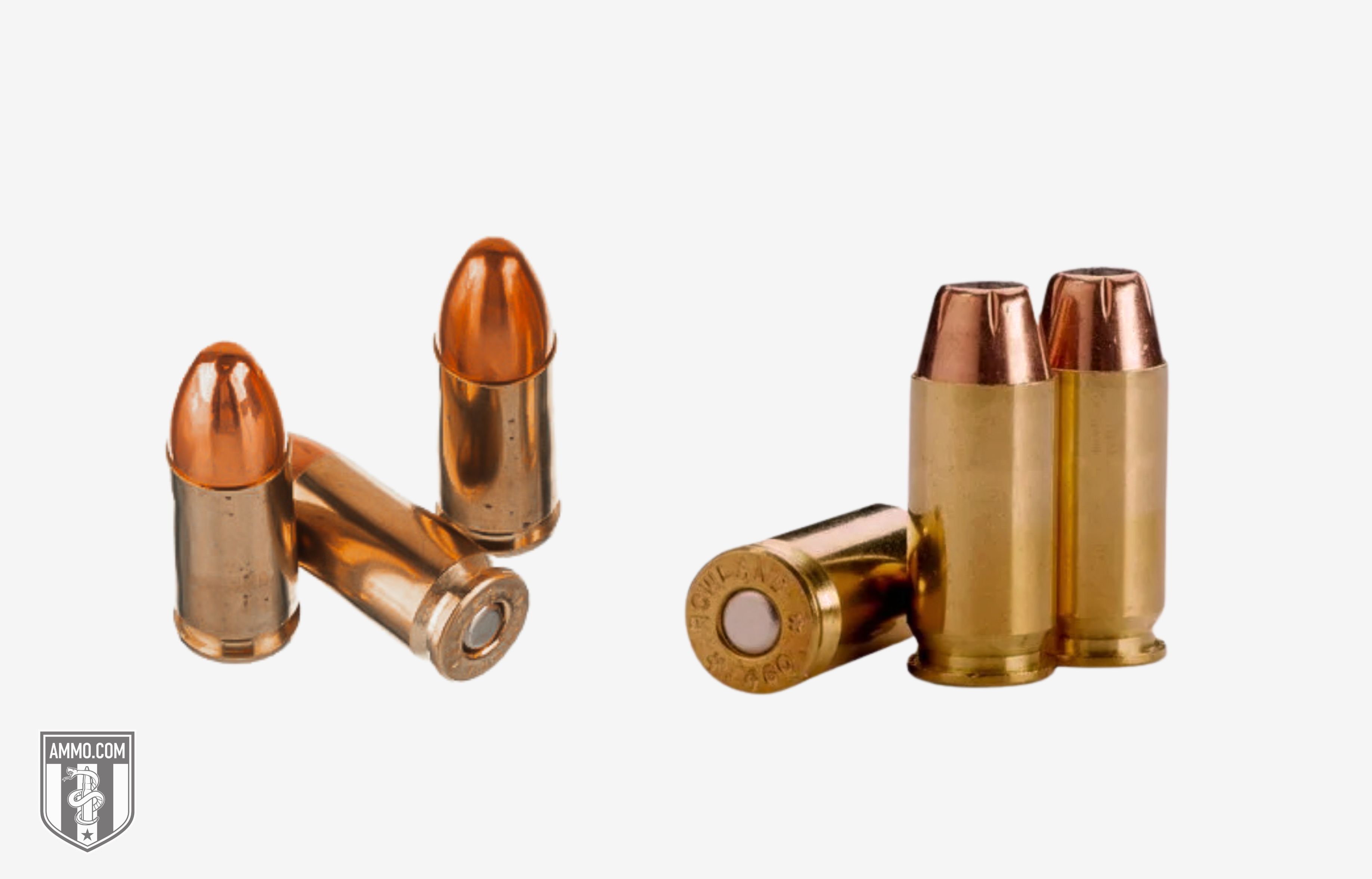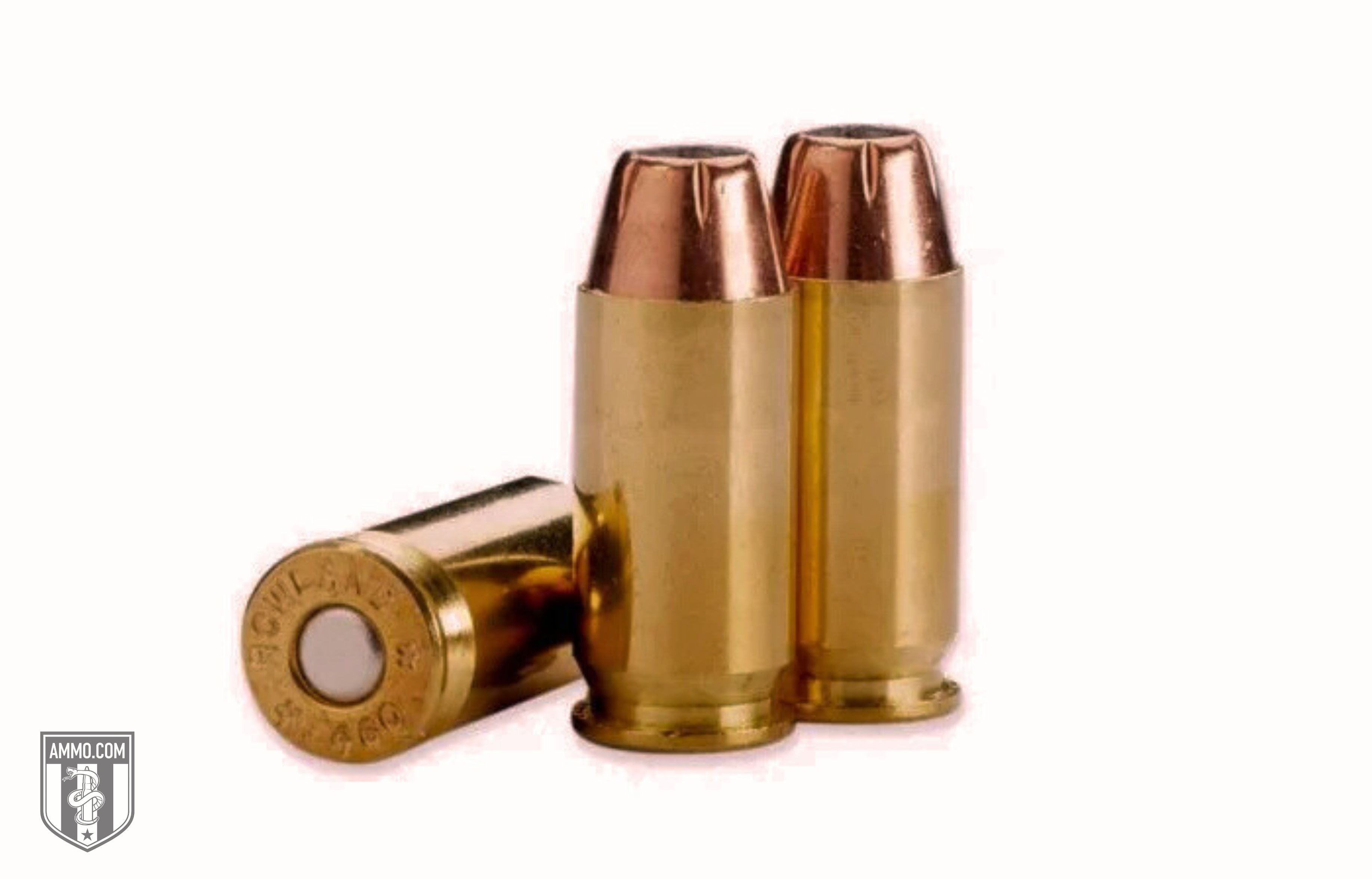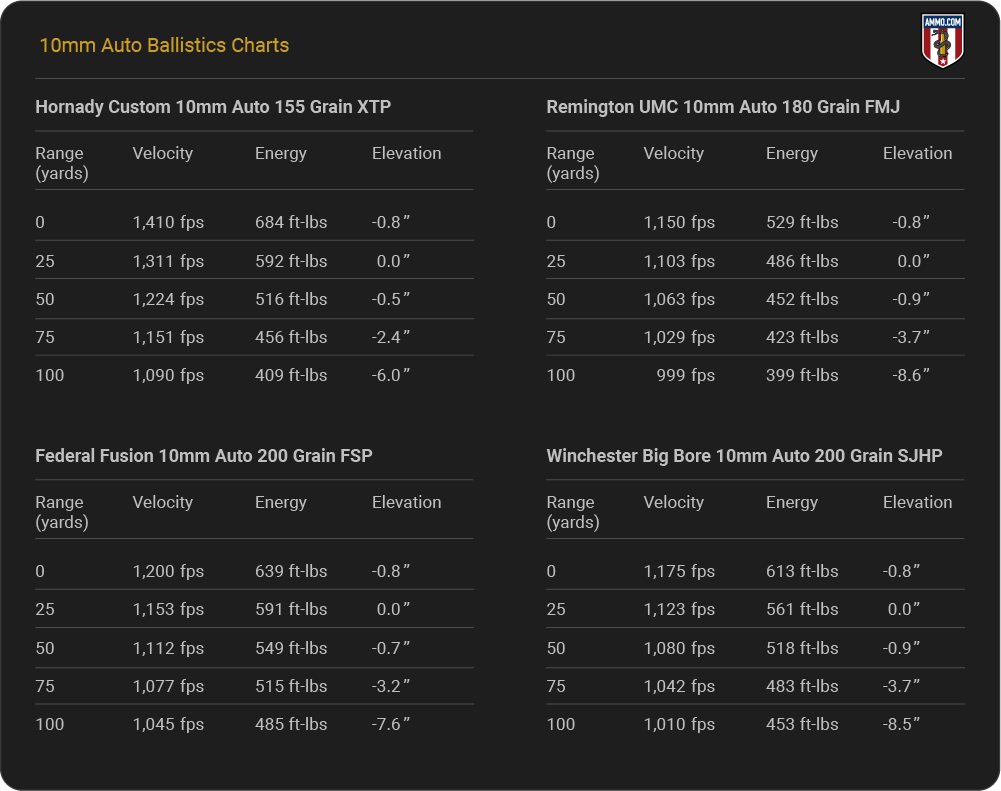460 Rowland vs 10mm: Which Pistol Cartridge Is Superior?

The 460 Rowland (sometimes incorrectly spelled Roland) and 10mm Auto are specialty handgun cartridges that make solid wilderness protection rounds. When we compare the 460 Rowland vs. 10mm, which one comes out on top?
Let’s compare the recoil, accuracy, pricing, ballistics, and more to find out!
What’s the Difference Between 460 Rowland vs. 10mm?

Despite being powerful handgun cartridges, many differences make one better than the other in various instances.
Their visual and size differences aren’t that drastic, as we'll see shortly. However, these minute variations can have significant impacts on real-world performance.
Cartridge Specs
Let’s get into the nitty-gritty details of technical specifications for each cartridge.
The 460 Rowland is the larger cartridge overall, measuring 1.275 in compared to 1.25 in for the 10mm. It's not a major difference, but it's noticeable.
The 460 Rowland fires a bullet with a larger diameter (0.452 in) contrasted with the 10mm (0.4005 in).
The 460 Rowland's longer case (0.957 in) gives it a little more case capacity; roughly the same as the 45 ACP at about 26.7 grains H2O. The 10mm has a case capacity of 24.1 grains H2O.
SAAMI-approved maximum chamber pressure for the 10mm Auto is 37,000 psi. SAAMI has not adopted official specs for the 460 Rowland, although consensus holds that it has a maximum pressure of 40,000 psi.

Let’s see how their dimensions determine real-world performance, beginning with the amount of recoil each cartridge produces.
Recoil: 460 Rowland vs. 10mm
Recoil is a critical consideration for all pistol shooters. A round with heavy recoil (aka “kick”) will be more challenging to control and effectively slow the rate of follow-up shots.
Recoil is the product of propellant weight, muzzle velocity (fps), bullet weight, and firearm weight. Assuming all other variables remain constant, the faster a bullet exits the barrel, the harder it kicks back on the shooter. (That’s just physics, folks.)
A heavier bullet requires more energy to push it out of the barrel at the same velocity as a lighter bullet. The extra resulting recoil energy is returned to the shooter’s wrists (in the case of firing a handgun).
A 10mm firing a 180 grain bullet generally has about 11.4 ft-lbs of energy. While this doesn’t seem like much, it does translate to what most shooters consider to be a snappy pistol-firing experience. That’s why the FBI no longer issues it.
The .460 Rowland has slightly more recoil than the 10mm, although most shooters won’t notice much difference.
This section is a tie, as felt-recoil is extremely challenging to distinguish between the two rounds.
Accuracy: 10mm vs. 460 Rowland
A round’s accuracy is determined by many factors, including the shooter, bullet, firearm, and environmental conditions. Trajectory and recoil also play a role (it’s much easier to be accurate with a round that has low recoil and a flat trajectory).
The accuracy of a cartridge also depends on personal preference, ammo selection, and the firearm you’re firing it in. Ammo retailers love talking about “accuracy,” but at the end of the day, no round is accurate until its owner makes it so.
The slight difference in recoil shouldn’t cause a shooter to flinch more with one than the other, except that the 10mm is more snappy than the 460 Rowland, which can translate into less accurate follow-up shots.
This section is a tie. Both cartridges have a similar amount of recoil, and either can be very accurate by practicing sound fundamentals.
Stopping Power: 460 Rowland vs. 10mm
“Stopping power” is a phrase commonly tossed around campfires, gun forums, and gun store counters. It is entirely unquantifiable, as it is ultimately and solely determined by shot placement. A well-placed shot with a small cartridge will always be more effective at stopping a threat than a poorly placed shot with a larger cartridge.
We can argue about bullet hole size, penetration, and energy transfer capabilities until we’re blue in the face and still get nowhere.
The .460 Rowland has a slight edge because it launches a larger bullet of similar weight at higher velocities. This generates more muzzle energy, translating to more energy available to transfer to the target downrange. It also penetrates better than the 10mm (depending on your chosen bullet).
The 460 Rowland is the first to win a section and takes the early lead. But can it hold on?
Hunting

Both handgun cartridges are used in hunting situations. The .460 Rowland cartridge was specifically designed to mimic the ballistic capabilities of the 44 Mag, which is an excellent close-range big-game hunting cartridge.
The rounds truly shine in bear defense situations, as they are powerful and penetrate deep enough to stop a charging bear in its tracks. Many hunters in Alaska load their 10mm sidearms with hard cast bullets for bear defense. The 460 Rowland can also be paired with hard cast bullets to stop a charging brown bear, black bear, or hog.
While neither is the most popular hunting cartridge, the 460 Rowland has a slight advantage. It was designed to perform similarly to the .44 Magnum and is chambered in some semi-auto rifles.
The 460 Rowland wins this section and extends its lead.
Self-Defense
Many characteristics make up a quality self-defense cartridge. High magazine capacity (this typically depends on the firearm you purchase), accuracy, quick reload time, and lower likelihood of overpenetration are a few that I always consider.
We know neither of these rounds lacks stopping power. They're both comparably accurate in the hands of a competent shooter.
The 10mm was initially intended to replace the 9mm and 45 ACP for law enforcement officers and military personnel. Self-defense enthusiasts also realized the 10mm's benefits, but it didn’t outperform the 9mm or 45 ACP enough to make these cartridges obsolete. It has a broader self-defense ammo selection and costs less to train with than the .460 Rowland cartridge as well.
Since the 460 Rowland is ballistically similar to the 44 Rem Mag, it’s not the best choice for human-sized threats because it’s more likely to over-penetrate and endanger innocent bystanders. However, JHPs and Glock conversion kits are available to turn your 45 ACP pistol into a .460 Rowland conversion, giving some CCWers all the reason they need to choose 460 Rowland for home and self-defense.
The 10mm is the better option for self-defense and wins this section.
Cost & Availability: 10mm vs. 460 Rowland
The 10mm significantly outshines the 460 Rowland in this section. Ammo costs are substantially less, and availability is considerably higher. If you want to do some plinking, even occasionally, the 10mm is the way to go.
Few factory firearms are chambered in 460 Rowland, which means you’ll need to purchase the FNX, Glock 21, Glock 30, Glock 41, or 1911 conversion kit, which includes the conversion barrel, recoil spring, compensator, and everything else you’ll need to switch your pistol to the 460 Rowland. If you’re uncomfortable doing the gunsmithing yourself after purchasing the kit from 460Rowland.com, be sure to find a reputable gunsmith in your area to do the conversion.
The 10mm Auto wins this section and ties up the overall comparison.
Reloading

Reloading is an excellent long-term option for saving money on ammo. However, handloading takes a significant initial investment in money and time.
Since 10mm and 460 Rowland ammunition are expensive, it’s well worth investing in a reloading press and supplies, no matter which one you purchase.
Both cartridges have plenty of load data and materials, so this section is a tie.
Ballistics: 460 Rowland vs. 10mm
Alrighty, all you number crunchers, this is the section you’ve been asking for: the ballistics of each cartridge. Which one is better on paper?
Well, the team at Ammo.com has compiled the ballistics of each one for you to compare and make a decision quickly.
460 Rowland Ballistics

10mm Ballistics

If you just can’t get enough numbers, feel free to take a deep dive into our 10mm ballistics article!
460 Rowland Brief History
Johnny Rowland and Clark Custom Guns designed the 460 Rowland in 1997 using the .45 ACP as the parent case. They aimed to produce a cartridge that could achieve actual .44 Magnum ballistic performance and be fired from a semi-automatic platform. Despite its name, the Rowland is an actual .45 caliber cartridge, like the 45 ACP.
While the 460 Rowland is lesser known than the 45 ACP or 44 Rem Mag, it still has a place among North American handgun hunters.
10mm Brief History
Lt. Col. Jeff Cooper, Whit Collins, and Irving Stone created the 10 mm Auto to have a flatter trajectory, stop threats at longer ranges than the beloved 45 ACP, and have a higher magazine capacity.
It didn’t take off initially, but Colt provided some help when it made the 1911 Delta Elite chambered in 10mm. The FBI eventually adopted the 10mm for a short time but ultimately determined that it had too much recoil for field agents to train with and accurately fire.
Today, like the 460 Rowland, the 10mm is a niche cartridge, most often used for bear defense and by a few self-defense enthusiasts who don’t mind carrying a hand cannon as their EDC.
Parting Shots: 460 Rowland vs. 10mm Auto
By now, you’ve learned that the 460 Rowland and 10mm aren’t that different, but their minor differences make each one better in specific instances.
When we compared the 460 Rowland vs. 10mm Auto, the 460 Rowland won two sections (stopping power and hunting). The 10mm Auto won two sections (self-defense and overall cost). Three sections were a draw.
The 460 Rowland is better for big game hunters. The 10mm auto is better for CCWers and target shooters.
Don’t forget to check out our large ammo selection at excellent prices at Ammo.com!
Ammo Comparisons
- .308 vs 5.56
- 6.5 Creedmoor vs .308
- .300 Blackout vs .308
- .300 Win Mag vs .308
- .243 vs .308
- .308 vs .30-06
- 7mm-08 vs .308
- .270 vs .308
- 7.62x39 vs .308
- .223 vs .308
- .338 Lapua vs .308
- .380 ACP vs 9mm
- .223 vs 5.56
- .300 Blackout vs 5.56
- 9mm vs 45 ACP
- 9mm vs 40 S&W
- .357 SIG vs 9mm
- 10mm vs 9mm
- 9mm vs 9mm Luger
- .243 vs .270
- .300 Win Mag vs .30-06
- .270 vs .30-06
- .40 vs .45
- 38 Special vs 357
- 9mm vs 40 vs 45
- 5.56 vs 7.62x39
- 338 Lapua vs .30-06
- .30-30 vs .30-06
- 300 PRC vs 338 Lapua
- .30-06 vs 7mm
- 300 Win Mag vs 338 Lapua
- 300 PRC vs 300 Win Mag
- 300 WSM vs 300 Win Mag
- 338 Win Mag vs 338 Lapua
- 12 Gauge vs 20 Gauge
- 10mm vs 357 Mag
- .30-30 vs 7.62x39
- 224 Valkyrie vs 22-250
- 17 HMR vs 22 Mag
- 7.62x39 vs .300 Blackout
- 45 ACP vs 45 Auto
- 45-70 vs 30-30
- 300 Blackout vs 223
- 357 Magnum vs 9mm
- 350 Legend vs 300 Blackout
- 224 Valkyrie vs 223
- 45 ACP vs 38 Super
- 6.5 Grendel vs .308
- 17 HMR vs 22 LR
- 10 Gauge vs 12 Gauge
- 22-250 vs 223
- 45 Colt vs 45 ACP
- 350 Legend vs 30-30
- 5.7x28 vs 223
- 5.7 vs 9mm
- 5.56 vs 5.7
- 22 vs 9mm
- Buckshot vs Birdshot
- 450 Bushmaster vs 308
- 450 Bushmaster vs 223
- Buckshot vs Slug
- 6.5 Grendel vs 5.56 vs 223
- 6mm ARC vs 6.5 Grendel
- 44 vs 45
- 458 SOCOM vs 5.56
- 357 vs 44
- 32 ACP vs 380
- 300 Win Mag vs 338 Win Mag vs 338 Lapua Mag
- 450 Bushmaster vs 458 SOCOM vs 50 Beowulf
- 6mm Creedmoor vs 6.5 Creedmoor
- TMJ vs FMJ
- 44 Special Vs 44 Magnum
- 45 90 vs 45 70
- 6.8 Western vs 6.8 SPC
- 50 Beowulf vs 50 BMG
- 26 Nosler vs 6.5 PRC
- 28 Gauge vs 410
- 6.8 SPC vs 5.56
- 6.8 SPC vs 6.5 Grendel
- 6.8 Western vs 7mm Rem Mag vs .28 Nosler
- 6.8 Western vs 6.5 Creedmoor
- 22 Hornet vs 223
- 6.8 Western vs 6.5 PRC
- .410 vs 12 Gauge
- .410 vs 20 Gauge
- 22 LR vs 22 Mag
- 6mm ARC vs 243
- 7mm-08 vs 270
- 243 vs 6.5 Creedmoor
- Nickel vs Brass Casing
- 204 Ruger vs 223
- 50 Beowulf vs 5.56
- 260 Remington vs 6.5 Creedmoor
- 6mm Remington vs 243
- 28 Nosler vs 300 PRC
- 50 Beowulf vs 50 AE
- 22 Nosler vs 22-250
- 450 Marlin vs 45-70
- 300 Win Mag vs 300 Norma
- 458 SOCOM vs 300 Blackout
- 38-55 vs 45-70
- 22 Hornet vs 22 LR
- 300 Norma vs 338 Lapua
- 338 Lapua vs 50 BMG
- 28 Nosler vs 300 Win Mag
- 28 Nosler vs 6.5 Creedmoor
- 204 vs 22-250
- 458 SOCOM vs 45 70
- 44 40 vs 45 70
- 6.8 SPC vs 6.5 Creedmoor
- 450 Bushmaster vs 30-06
- 7mm Rem Mag vs 300 Win Mag
- 30 Carbine vs 223
- 25-06 vs 30-06
- 26 Nosler vs 28 Nosler
- 16ga vs 12ga
- 30 06 vs 7.62 x54R
- 9mm Makarov vs 9mm Luger
- 350 Legend vs 223
- 30 Carbine vs 5.56
- 6.5x55 vs 6.5 Creedmoor
- 6.5 Creedmoor vs 270 vs 25-06
- M193 vs M855
- 450 Bushmaster vs 458 SOCOM
- 6.5 Grendel vs 6.5 Creedmoor
- 350 Legend vs 5.56
- .277 Fury vs 6.8 SPC
- 277 Fury vs 300 Win Mag
- 10mm vs .45 ACP
- 277 Fury vs 223
- 6.8 SPC vs 300 Blackout
- 6.5 PRC vs 6.5 Creedmoor
- 277 Fury vs 308
- 277 Fury vs 6.5 Creedmoor
- 350 Legend vs 450 Bushmaster
- 277 Fury Vs 5.56 NATO
- 10mm vs 40S&W
- 32 ACP vs 9mm
- 32 Special vs 9mm
- 8.6 Blackout vs 300 Blackout
- 30 Super Carry vs. 9mm
- 5.56 vs 9mm
- .50 Action Express vs 9mm
- 7.62x25 vs. 9mm
- 10mm vs 44 Magnum
- 300 Blackout vs 300 Win Mag
- 6.5 Grendel vs 300 Blackout
- 460 Rowland vs 10mm
- 300 RUM vs 300 PRC
- 300 Norma vs 300 PRC
- 45 GAP vs 45 ACP
- 7mm PRC vs 300 Win Mag
- 300 PRC vs 6.5 Creedmoor
- 300 PRC vs 308
- 357 SIG vs 357 Mag
- 7.62x39 vs 7.62x51
- 243 Win vs 223 Rem
- 30 Nosler vs 300 PRC
- 6.5 Creedmoor vs. 30-06 Springfield
- 450 S&W vs. 44 Magnum
- 6.5 Creedmoor vs. 300 Win Mag
- 454 Cassull vs. 45-70 Govt
- 454 Cassull vs. 44 Mag
- 7.62x54r vs. 308 Winchester
- 22 ARC vs. 223 Rem
- Subsonic vs. Supersonic Ammo


